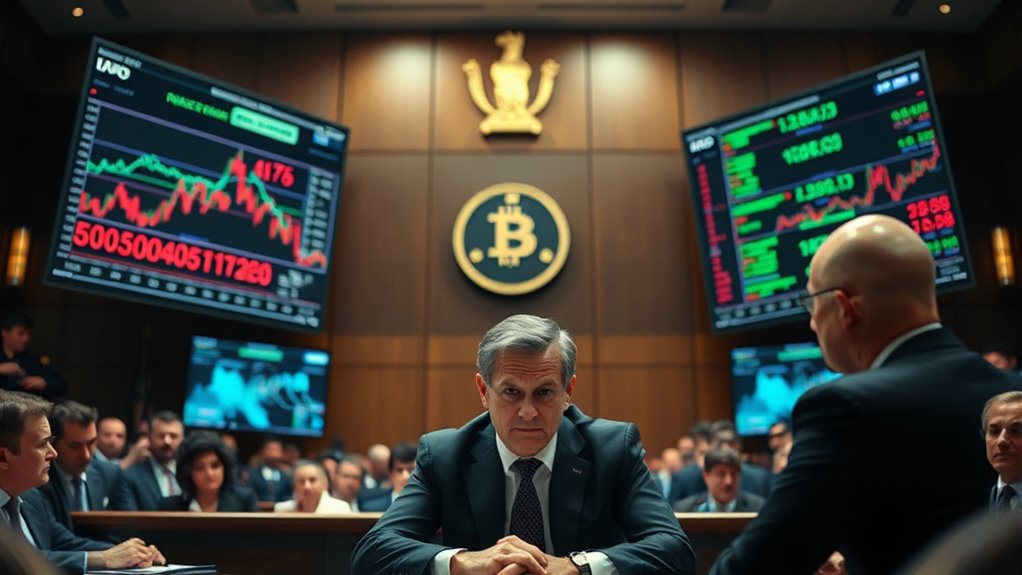Sam Bankman-Fried’s journey from a crypto superstar to courtroom defendant showcases a dramatic collapse of trust. He faced charges of fraud and deception that led to his guilty verdict and a 25-year prison sentence, highlighting the scale of his scheme that caused billions in losses. His case has reshaped the crypto landscape, emphasizing the need for transparency and regulation. Discover more about how his actions changed the industry forever.
Key Takeaways
- Sam Bankman-Fried was convicted in November 2023 for orchestrating a massive crypto fraud involving FTX.
- He pleaded not guilty but was sentenced to 25 years in prison and forfeited over $11 billion.
- Key testimony from former colleague Caroline Ellison exposed top-level deception and rule-breaking.
- The scandal caused billions in customer losses and led to FTX’s bankruptcy, impacting industry trust.
- The case has prompted increased regulatory scrutiny, emphasizing transparency and accountability in crypto markets.

Throughout the legal process, Bankman-Fried maintained his innocence, pleading not guilty and insisting that his actions were reasonable business decisions, albeit with some unforeseen consequences. The trial, which began in October 2023 and culminated in a guilty verdict in November, was a high-stakes confrontation. You saw Bankman-Fried testify over three days, trying to explain his side, while prosecutors highlighted the scale of the deception—an elaborate scheme that resulted in billions of dollars lost by customers and creditors. Caroline Ellison, a key prosecution witness, detailed how Bankman-Fried disregarded rules and orchestrated the fraud from the top. The judge sentenced him in March 2024 to 25 years in prison, a significant reduction from the 40-50 years prosecutors recommended, but still a heavy penalty. He’s also ordered to forfeit over $11 billion, reflecting the gravity of his crimes. This case isn’t just about one man’s legal troubles; it’s reshaping the crypto landscape. FTX’s bankruptcy left nearly $16 billion recovered for creditors, with plans to liquidate assets and repay about 98% of claims. Customers are likely to recover a portion of their lost funds, but the trust in crypto exchanges has taken a massive hit. The scandal also triggered increased regulatory scrutiny, as authorities seek to prevent similar frauds. You see the aftermath in the ongoing efforts to tighten oversight and restore confidence in the industry. Bankman-Fried’s story is a stark reminder of how quickly a crypto empire can crumble when deception and mismanagement take hold. His legal saga marks a turning point—highlighting the importance of transparency, regulation, and accountability in this volatile sector. Additionally, the case emphasizes the need for regulatory oversight to protect investors and maintain market integrity.
Frequently Asked Questions
What Specific Charges Does Sam Bankman‑Fried Face?
You’re asking about the specific charges against Sam Bankman-Fried. He faces seven criminal counts, including securities fraud, wire fraud, and money laundering. Prosecutors allege he orchestrated a massive scheme, misappropriating over $8 billion from FTX customers, funneling funds to Alameda Research for personal and risky investments. His actions led to one of the largest financial crimes in U.S. history, resulting in his 25-year prison sentence.
How Did FTX Collapse Impact the Crypto Industry?
You see, the FTX collapse shook the crypto industry to its core. It caused over $1.8 trillion in losses, triggered a market plunge, and led to many firms facing bankruptcy or liquidity issues. Investors panicked, and trust in crypto plummeted. Regulatory bodies stepped up, demanding stricter rules. Recovery efforts are ongoing, but the ripple effects exposed serious weaknesses in risk management and transparency across the crypto ecosystem.
What Defenses Is Sam Bankman‑Fried Likely to Present?
Think of his defense as a house built on shaky ground. You might argue he lacked criminal intent, claiming each decision seemed reasonable at the time. He’ll likely point to complex business practices, not deliberate fraud, and blame external factors like biased legal teams and media hype. He may also challenge the evidence, argue procedural errors, and portray himself as a victim of circumstance, trying to sway the court’s perception.
How Are Crypto Regulations Evolving in Response?
You see, crypto regulations are evolving quickly to create clearer rules and reduce uncertainty. New laws like FIT21 define asset classifications and set compliance standards, while agencies like OCC, SEC, and CFTC adjust their enforcement strategies. The government aims for a more permissive environment, encouraging innovation but still enforcing AML and consumer protections. These shifts influence how crypto companies operate, potentially making compliance easier and fostering growth in the industry.
What Are the Potential Penalties if Convicted?
If you’re convicted, the penalties could be staggering, exceeding anything you’ve imagined. You might face a maximum of over a century behind bars, with a colossal $11 billion forfeiture looming over you. Imagine a 25-year prison sentence, plus supervised release, and the possibility of your entire fortune vanishing in a flash. These penalties serve as a powerful warning — in the world of financial crimes, the consequences are truly monumental.
Conclusion
Now you see how Sam Bankman-Fried’s story transforms from crypto fraud to courtroom drama, from scandal to scrutiny, from deception to justice. You witness the rise, the fall, and the fight for accountability. You understand the complexities and consequences that shape this legal saga. And as the story unfolds, you realize that justice isn’t just about accusations or defenses, but about truth, transparency, and the pursuit of fairness in a world driven by technology and trust.










